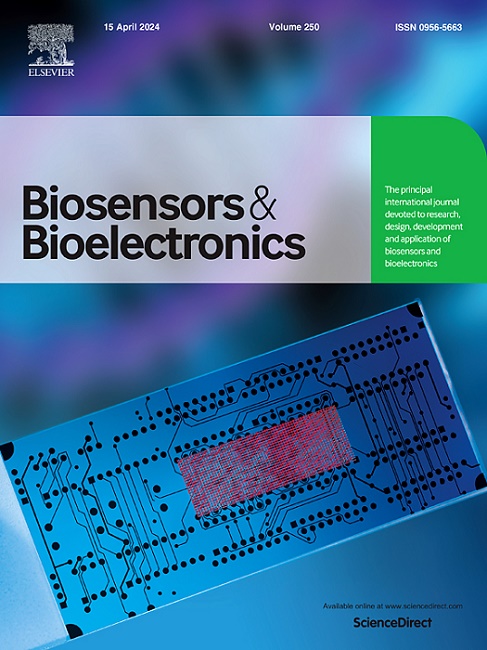可定制的 OpenGUS 免疫测定:使用β-葡萄糖醛酸酶开关和无标记抗体的均质检测系统
IF 10.7
1区 生物学
Q1 BIOPHYSICS
引用次数: 0
摘要
我们开发了一种可定制的 OpenGUS 免疫测定,无需对抗体进行修饰即可快速灵敏地检测分析物。这种免疫测定采用了无标记全抗体、源自葡萄球菌蛋白 A 的抗体结合 Z 结构域 (ZD) 和 β-葡糖醛酸酶 (GUS) 开关突变体,从而可以轻松替换抗体,针对各种目标抗原定制免疫测定。其工作原理是,OpenGUS 探针是 ZD 和 GUS 开关的融合蛋白,通过一锅反应将抗体与抗原的相互作用转化为 GUS 激活。为了提高免疫测定的信噪比,我们通过筛选对角界面残基 H514 的几个额外突变,开发出了一种能降低背景激活的 GUS 开关突变体。此外,我们还优化了反应缓冲液的成分,包括有机溶剂、盐和表面活性剂。在最佳条件下,我们定制了针对 Cry j 1、人 C 反应蛋白和人乳铁蛋白的 OpenGUS 免疫测定,只需使用市售的 IgG,就能实现约 10-20 倍的最大荧光反应(15 分钟)或比色反应(2 小时),检测限为皮摩尔至低纳摩尔水平。此外,我们还成功地在与实际应用类似的复杂基质中检测到了这三种分析物。我们相信,这种可定制的 OpenGUS 免疫测定将为快速开发用于护理点诊断、高通量测试和现场环境评估的快速、灵敏的均相免疫测定铺平道路。本文章由计算机程序翻译,如有差异,请以英文原文为准。
Customizable OpenGUS immunoassay: A homogeneous detection system using β-glucuronidase switch and label-free antibody
We developed a customizable OpenGUS immunoassay that enables rapid and sensitive detection of analytes without requiring antibody modification. This immunoassay employs label-free whole antibodies, an antibody-binding Z domain (ZD) derived from Staphylococcal protein A, and a β-glucuronidase (GUS) switch mutant, allowing for easy replacement of antibodies to tailor the immunoassays for various targeted antigens. The working principle is that the OpenGUS probe, the fusion protein of ZD and a GUS switch, converts the antibody-antigen interaction into GUS activation in a one-pot reaction. To enhance the signal-to-background ratio of the immunoassay, a GUS switch mutant that exhibits reduced background activation was developed by screening several additional mutations at the diagonal interface residue H514. Moreover, we optimized the composition of the reaction buffer, including organic solvents, salt, and surfactant. Under optimal conditions, we customized OpenGUS immunoassays for Cry j 1, human C-reactive protein, and human lactoferrin, achieving around 10–20-fold maximum fluorescence (15 min) or colorimetric (2 h) responses with picomolar to low nanomolar level detection limit, simply by using commercially available IgGs. Additionally, the three analytes were successfully detected in complex matrices similar to those used in practical applications. We believe that this customizable OpenGUS immunoassay will pave the way for the prompt development of rapid and sensitive homogeneous immunoassays for point-of-care diagnostics, high-throughput testing, and onsite environmental assessments.
求助全文
通过发布文献求助,成功后即可免费获取论文全文。
去求助
来源期刊

Biosensors and Bioelectronics
工程技术-电化学
CiteScore
20.80
自引率
7.10%
发文量
1006
审稿时长
29 days
期刊介绍:
Biosensors & Bioelectronics, along with its open access companion journal Biosensors & Bioelectronics: X, is the leading international publication in the field of biosensors and bioelectronics. It covers research, design, development, and application of biosensors, which are analytical devices incorporating biological materials with physicochemical transducers. These devices, including sensors, DNA chips, electronic noses, and lab-on-a-chip, produce digital signals proportional to specific analytes. Examples include immunosensors and enzyme-based biosensors, applied in various fields such as medicine, environmental monitoring, and food industry. The journal also focuses on molecular and supramolecular structures for enhancing device performance.
 求助内容:
求助内容: 应助结果提醒方式:
应助结果提醒方式:


